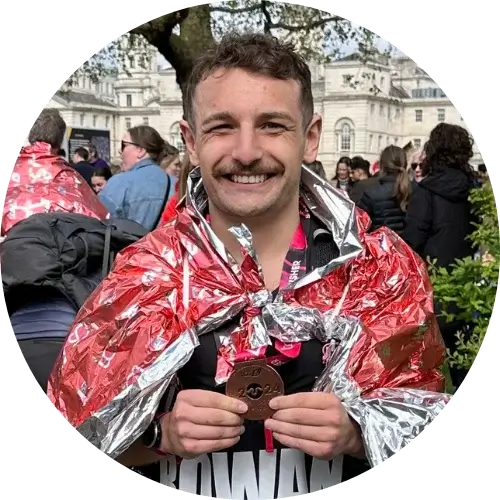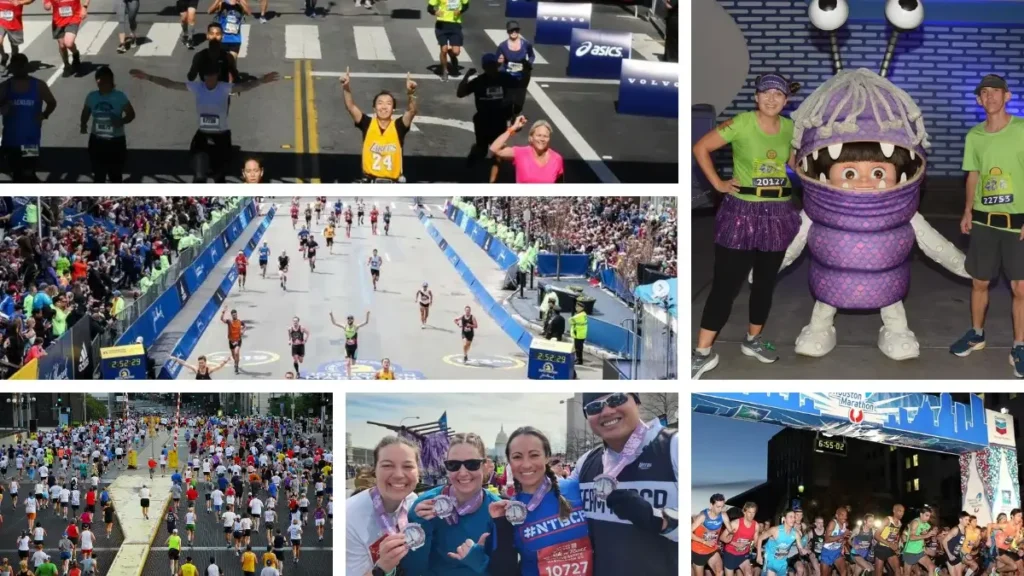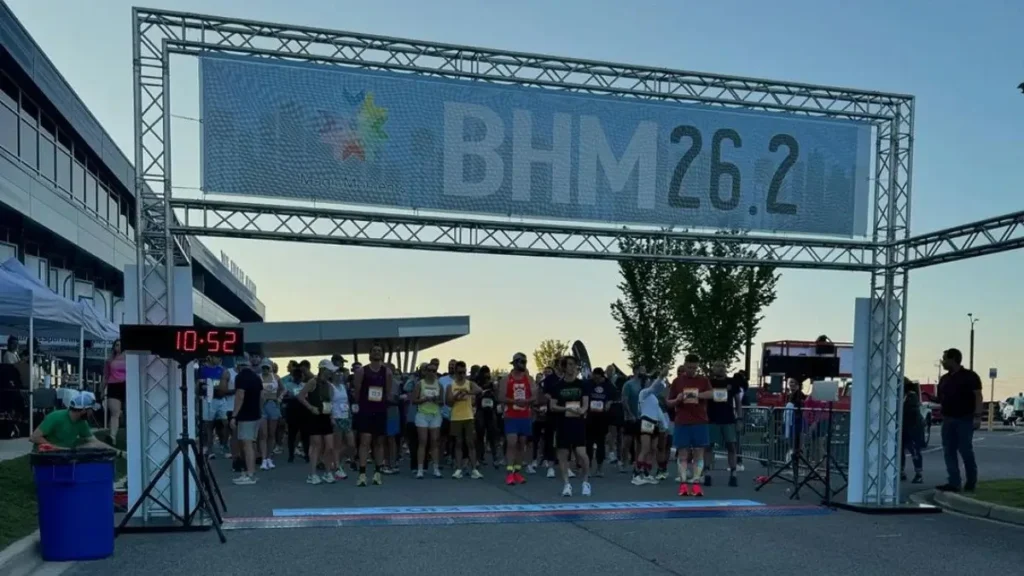The best marathons in Washington are:
The state’s marathon scene stretches from dense city streets to quiet forest trails, with race days shaped by weather that can swing from crisp autumn skies to cool coastal mornings.
Some courses show off Seattle’s skyline, others follow rivers and valleys, and a few take runners through tunnels or along the edge of the Olympic Peninsula. Together, they create a mix that’s as varied as the state itself.
Check out my Top 50 Best Marathons in the US, or choose another state:
Seattle Marathon
Seattle | Nov 30, 2025


Course Type: Hilly
Elevation Gain: 942 feet (287m)
Participants: 2,017 Finishers (2024)
Price: $100-$210
The race starts at Seattle Center near the Space Needle and now finishes at Bell Harbor Pier 66. The course heads through downtown before shifting onto the I-5 express lanes, then crosses the Ship Canal Bridge into the University District. It is a rolling course with steady elevation changes that keep things interesting without being overwhelming. With race day always landing in late November, runners usually get cool, crisp air that suits marathon pacing.
Before race day, the Health and Fitness Expo at The Westin Seattle is where runners pick up bibs, participant shirts, and finisher medals. It also serves as a gathering spot for pacers, vendors, and runners who want a little pre-race buzz. Packet pickup happens only at the expo, so planning ahead is key.
The marathon officially reopens the course to traffic at 2:30 p.m., but runners can still complete the race after that point if they follow pedestrian rules. It makes for an event that is both welcoming to first-timers and still competitive for those chasing a time.
From start to finish, the Seattle Marathon mixes the city’s urban core with waterfront views, campus stretches, and bridges that show off Seattle’s landscape. It is a race with history, quirks, and enough variety on the course to keep runners engaged the whole way.
Windermere Marathon
Spokane, WA | May 17, 2026


Course Type: Mostly Flat
Elevation Gain: 456 feet (139m)
Participants: 172 Finishers (2025)
Price: $90-$140
This Spokane race doesn’t go for flash but has its own appeal. It’s a spring point-to-point course that finishes in downtown Riverfront Park, with a reputation for being fast and friendly to Boston hopefuls. The route follows the Centennial Trail along the Spokane River, giving runners a mix of flat stretches, bridges, and park views on the way into the city.
The start is near Liberty Lake, and the course moves west into Spokane before wrapping up in Riverfront Park beside the clocktower and pavilion. It’s certified, so times count toward Boston qualification, and the steady profile makes it easy to settle into pace without fighting tough hills. Many runners point out that the half marathon, which shares the back half of the full route, has a nice gradual downhill almost the whole way.
Packet pickup happens the day before at AutoNation Toyota Spokane Valley, and race morning begins early with an optional 5:30 a.m. start before the main field heads out at 7:00 a.m. Other events, from the half to the kids run, stagger throughout the morning.
Finishers walk away with a long-sleeve tech shirt, a medal, chip timing, food at the end, and the option to grab extra swag like a commemorative hoodie. Aid stations line the course, and pacers have been part of past races for those chasing specific times.
All told, it’s a simple, fast, well-supported race.
Jack & Jill’s Downhill Marathon
Snoqualmie Pass, WA | Jul 25–26, 2026
Course Type: Downhill
Elevation Gain: 76 feet (23m)
Participants: 715 Finishers (2025)
Price: $149
Jack & Jill’s starts inside a dark two-mile tunnel where headlamps are a must. Once you emerge, the course drops nearly 2,000 feet as it follows the John Wayne Pioneer and Snoqualmie Valley Trails from Hyak down to North Bend. It’s a rare marathon that’s all downhill but somehow feels flat, in part because the drop is so gradual you hardly know it’s happening. The trail stays shaded for most of the run, which keeps things cool even in late July. But near the end, the canopy thins, and the sun can sneak in. The warmth is very welcome after miles of cool forest.
Runners ride shuttle buses to the start, then head out in rolling waves by pace. Aid stations appear every couple of miles, and spectators gather at a handful of points, mile 13, 16, 21, and the finish, to give welcome boosts. The gravel surface can sneak up on tired quads, but the smooth descent makes this a favorite for Boston hopefuls and anyone chasing a fast time.
The finish near downtown North Bend delivers open views and a lively end to a unique race that blends a tunnel start, evergreen shade, and steady downhill speed
North Olympic Discovery Marathon
Port Angeles, WA | Jun 6–7, 2026
Course Type: Hilly
Elevation Gain: 877 feet (267m)
Participants: 271 Finishers (2025)
Price: $80
It’s hard not to get quiet watching the miles unfurl along the Olympic Discovery Trail. The marathon begins on a bit of grass (a set of soccer fields just outside Blyn) before shifting onto the trail itself, which is wide enough to feel roomy and almost entirely paved. The opening miles ease you on with a slight uphill, one of six gentle climbs peppered throughout, the longest stretching across a full mile. Once those rollers settle, the path descends toward Port Angeles, and the course effortlessly invites rhythm and focus.
Along the way, runners cross trestle bridges and follow stretches beside the shoreline where eagles, seals, and other wildlife are often spotted. The course is held in early June, when temperatures usually sit between the upper 40s and mid-60s, making for cool and steady conditions.
Aid stations appear every couple of miles, and mile markers keep the course easy to follow. In the last five miles the trail opens up to views of the Strait of Juan de Fuca on one side and the Olympic Mountains rising on the other. The finish line sits at the Port Angeles City Pier, where the waterfront setting gives the race a natural conclusion.
The marathon is USATF certified and can be used to qualify for Boston, but many runners talk about the scenery and relaxed atmosphere as the details that stand out most once the race is done.
Running Through Seasons in Washington
Marathons in Washington don’t all feel the same, and a lot of that comes down to the season. A spring race along the Spokane River might give you cool mornings and fresh green on the trees, while a summer run in the Cascades means more sun, warmer air, and the possibility of a dry, dusty trail underfoot. Fall races tend to bring crisp air and changing colors, especially around Seattle’s neighborhoods and parks. And winter? It’s rare, but a late-November marathon in the city can mean anything from drizzle to bright blue skies. The shifting seasons shape the atmosphere as much as the course does.
Washington Running Culture
Running here is as much about community as it is about miles. Seattle’s big city events bring together thousands of people, but smaller races across the state often have a neighborhood feel, with volunteers who know the course as well as the runners do. Trail running is woven into the culture too, and it influences how road races are designed – shaded paths, routes along rivers, and stretches that feel closer to nature than traffic. It’s a mix that makes marathon weekends feel both organized and personal, whether you’re in a crowd downtown or passing through a quiet stretch of forest.
Conclusion
Marathons in Washington carry the state’s contrasts right into the stride. You can take on city streets that climb and dip past landmarks, chase fast times along river trails, or settle into the quiet rhythm of coastal running. Each race has its own character, but what ties them together is the sense of place – water, mountains, and green spaces shaping the miles. Whether you’re chasing a time or just chasing a good run, Washington makes the effort feel worth it.

Row Brown is the founder of Refresh Row. He is a keen marathon runner, his favorite being the London Marathon. He’s now set himself the mission of Running the Entire Length of Spain, which is scheduled for late 2024.


